Don’t know how to start? Follow our easy step-by-step guide and make your shopping worry-free.
Buying cookware seems like a challenge because these vessels have huge range of options — types, shapes, brands, materials, prices or even designs. But our guide can break through this: It’s clear-cut to understand without complicated information, cuts down the choices, and goes straight to your needs by step-by-step guide. Let’s jump in!
Too rush to learn? View our editor’s Top Picks Products to ensure you’ll get the best one in short-cut of time.
Of all, your cooking routines will decide your best cookware. If don’t know where to start, these questions, at least, should be asked to roughly assess what you should look for:
Why material is matter?
The answer is heat conductivity that can indicate how good of heat conductivity, how durable of the construction, and how easy to care or what technique can be used. Say, it has a big influence on cooking quality.
Each material has different heat transferable performance or ability to react to temperature changes. Some metals heat up and cool down very fast, but some others stay hot much longer after taking times to heat.
Still, some metals, like stainless steel, have bad conductive ability so they need to infuse conductible metals inside to improve the heat transmission.
The most common materials for cookware are stainless-steel, aluminum, cast-iron, carbon steel and copper. See more about cookware materials, heat conductivity and cooking techniques that suit for each one, see The Big Guides: Cookware Materials.
“Good conductor and heavy gauge are the key features of good cookware”, advises Fine Cooking Editor Amy Albert. Heavy-gauge pans deliver heat more evenly, and aren’t easy to dent and warp
Before buying a pan, she recommended to life it, check the thickness of the walls and base and knock it with your knuckles to hear a dull thud sound, a light ping — to check how dense of the pan, which ensure you’ll get a good one.
Apart from conductive materials, the cooking surface plays extremely big role — The material that contact with food can indicate:
These are most common cooking surfaces:
Stainless-Steel
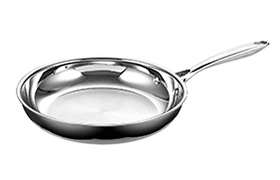
Stainless steel — an alloy of steel, carbon, and chromium — is undoubtedly the most common cooking surface. It’s durable, scratched-resistant, non-warp, and looks good.
Precautions:
Non-Stick
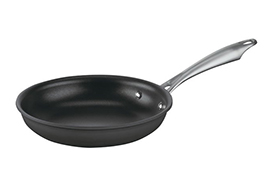
Traditional non-stick surfaces are coated by the polymer PTFE-or polytetrafluoroethylene (Teflon) that keeps food from sticking, without adding any fats.
Precautions:
Porcelain
Enameled
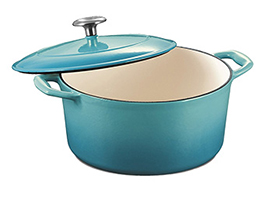
Enameled surface is often found on good heat conductor like cast iron, which feel smooth surface and easy to clean. It’s good for slow cooking tools, like Dutch ovens, and cooking reactive foods.
Precautions:
Cast Iron & Carbon
Steel
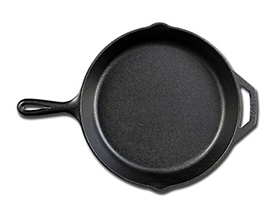
Uncoated cast-iron and carbon steel surfaces have naturally nonstick feature — they will develop nonstick after times of uses. For longer lifetime, these surfaces need proper care.
Precautions:
Some materials, like bare aluminum, tin, copper or cast-iron, can react to acidic, sulfurous, and alkaline foods. This can make the foods taste metallic and get discoloration — Eggs, vegetables in the cabbage family and baking soda are vulnerable to aluminum’s graying effect.
Also, some metals might raise health risks. For example, aluminum is suspected to link to Alzheimer, but there is no clearly evidence at this time.
So, if you cook reactive foods, such as tomato, fruit filling or wine, ensure to use non-reactive surfaces, like stainless-steel, enamel and hard-anodized aluminum. Learn more about Cooking Materials and Food Safety.
When talking about ‘design’ in cookware term, it doesn’t mean only just the beauty but rather imply to practicality and usability — good cookware construction should require good ergonomic design, weight in hand, comfortable handle or even drip-free rims.
What to Look For
These are common checklists before buying:
Handle
Lid
Weight
Rim
Shape
When buying cookware, there are many debates here:
Most experts might recommend you buy pieces you need. We agree, if budget is unworried, this is ideal choice. Also, this is good for occasional cooks who don’t cook much or amateurs who cook some certain recipes, having a good nonstick skillet will be fine.
In the other hand, buying whole set looks way more value than buying al la carte but trades-off with some unwanted pieces. Still, the final decision hinges on your needs: cooking habits, level of cooking or even how much to spend.
Keep in mind: Many cookware tools are versatile — they can do multi-functions. So, unless you are an enthusiastic home chef, you don’t really need every pot and pan. Only some essential pieces are enough for daily cuisines. See The Essential Pots and Pans You’ll Need for Every Kitchen.
For the optimum choice between usability and value, we recommended 2 options:
Buy a complete practical set. Buy a full-sized, commonly offering 10 to 12 pieces, set that fills with workable pieces.
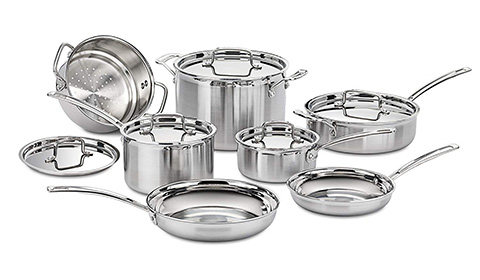
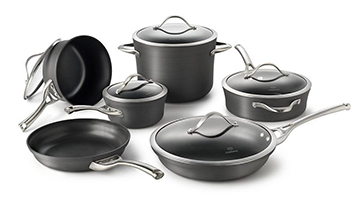
The Cuisinart Multi-Clad Pro (12-piece) set is the good sample as having enough essential pieces for daily culinary tasks. But, if you like nonstick cooking, consider Calphalon Contemporary Nonstick (11-piece) set.
Buy a small set (or essential pieces) and add others later. If you have more budget and time, buy some essential pieces, such as a saucepan, a skillet and a stockpot, or a small set first. Later, you can fill your collection by adding other tools you need, like omelet pans, roasting pans or Dutch ovens.
This allows you to have most-utilized tools while visibly save money than buying full collection piece-by-piece.

For example, you might pick the quality All-Clad Tri-Ply (7-piece) set that offers a fry pan, two sauce pans and a stock pot. Then, add some handy pieces, like a 10.25” nonstick pan and a sauté pan, or else later.
Price of cookware mainly varies by material, feature, construction and brand.
Stainless-Steel. The price depends on layer and type of conductive materials — the more layers or higher conductors, the more price. Normally, a 10-piece fully clad set sells for $250 to $1,000 while an encapsulated disc one, like Cuisinart Chef’s Classic, is much cheaper, $70 to $200.
Brand is matter. An All-Clad tri-ply set, costs $700* some mid-range brands, like Cuisinart or KitchenAid, offer under $300.
Gas burner is most handy since is compatible with most cookware materials. Still, if you have other type of ranges, don’t forget to check these:
Some products carry very long or lifetime warranty. You might have a peace of mind that your pots and pans are ensured all over freely usage. However, the fact is not like that. Most warranties will cover only any production or material defects, not from misuse or accidents.
To ensure your insurance, follow the guides strictly.
After all, if you still feel this too hard to choose the right ones, look up here: